Ever wondered exactly what they do at Weta Workshop and Weta Digital? Richard Taylor talks about their work in this neat little clip. Plus there’s some footage and red carpet interviews from the Wellington premiere of The Hobbit: An Unexpected Journey that you may not have sen previously. Continue reading “Richard Taylor talks about Weta’s work”
Category: Premieres
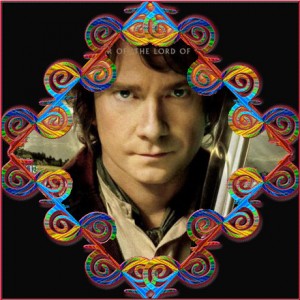 ‘The Hobbit: An Unexpected Journey‘ is a fulfilling and entertaining adventure that is sure to please most Middle-earth enthusiasts. Filled with direct book-to-screen moments and some unique new additions, the film stands as a strong first installment of a three-year adventure. If you think of it as a fine art masterpiece in a beautiful museum, it can sit proudly next to its LOTR siblings. Well, sorta. You see, someone chose an overly busy frame with bright colors and fancy patterns that distracts from the essential content. Luckily, in your experience, you can easily swap out the frame.
‘The Hobbit: An Unexpected Journey‘ is a fulfilling and entertaining adventure that is sure to please most Middle-earth enthusiasts. Filled with direct book-to-screen moments and some unique new additions, the film stands as a strong first installment of a three-year adventure. If you think of it as a fine art masterpiece in a beautiful museum, it can sit proudly next to its LOTR siblings. Well, sorta. You see, someone chose an overly busy frame with bright colors and fancy patterns that distracts from the essential content. Luckily, in your experience, you can easily swap out the frame.
As you’ll read later, this reviewer suggests this may be the wisest course first-up.
As an adaptation and expansion on Tolkien’s 75-year-old children literature classic — emphasis on children — this film is more fantastic and at times more ‘cartoony’ than its trilogy predecessor. A quick example… while in The Lord of the Rings: The Fellowship of the Ring we see the four Hobbits trying to escape Farmer Maggot and falling down a long slope with nothing but a broken carrot, in The Hobbit: An Unexpected Journey we see the Company of Thorin falling down a 1000-foot crevasse (multiple times) and simply dusting themselves off.
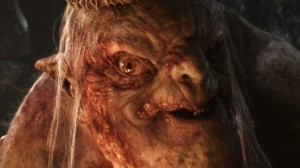 That theme permeates the film. The ‘bad guys’ are not quite horrible monstrosities that cause death and destruction but instead are similar to villains in an episode of the A-Team. You know, where no matter how many times they shoot at our heroes, they never actually hit their mark. It ultimately makes for exciting confrontations, but no real concern the heroes will meet their doom. Some who are not familiar with the childish nature of The Hobbit might find this a bit odd when they compare the drama to the LOTR films.
That theme permeates the film. The ‘bad guys’ are not quite horrible monstrosities that cause death and destruction but instead are similar to villains in an episode of the A-Team. You know, where no matter how many times they shoot at our heroes, they never actually hit their mark. It ultimately makes for exciting confrontations, but no real concern the heroes will meet their doom. Some who are not familiar with the childish nature of The Hobbit might find this a bit odd when they compare the drama to the LOTR films.
The acting by the core cast was astoundingly good. Martin Freeman IS Bilbo Baggins and as expected delivers an amazing performance with true emotion, humor and feeling. Ian McKellen is a less serious version of his LOTR-self and in many ways a lot more likable. His sense of humor comes across more in the performance and it is very endearing. Richard Armitage delivers a dead-on performance of Thorin. For those of us who know what the future holds for Thorin, I can clearly state the casting was perfect. Andy Serkis returns as Gollum and provides yet another amazing performance. ‘Riddles in the Dark’ will be one of your favorite scenes — guaranteed!
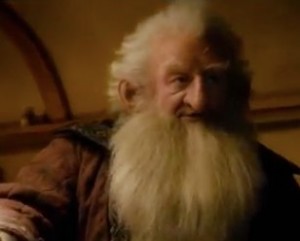 The dwarves were always a bit of a concern for me because I thought we’d be spending a lot of time getting to know each and dealing with lot of childish humor. This is not the case. They do all get introductions and each has their own distinct and unique contribution to the film. There is of course some ‘potty’ humor, but nothing that is overdone or inconsistent. Ken Stott as Balin delivers a stand-out performance — one that does not go unnoticed and puts him on par with the other key players.
The dwarves were always a bit of a concern for me because I thought we’d be spending a lot of time getting to know each and dealing with lot of childish humor. This is not the case. They do all get introductions and each has their own distinct and unique contribution to the film. There is of course some ‘potty’ humor, but nothing that is overdone or inconsistent. Ken Stott as Balin delivers a stand-out performance — one that does not go unnoticed and puts him on par with the other key players.
The rest of the cast provide strong performances but some are a bit constrained by the visual performance that accompanies their acting. If you are looking for the awesomeness of The Goblin King from Rankin/Bass, I fear you will be a bit disappointed. And Radagast, while semi-interesting and fun in a childish sense (which is okay!), seems to be just thrown in to have another wizard.
Some of the folks I saw the film with had issues with the ‘slowness’ of the story, but I did not. I was surprised how fast the film felt – when it ended I was surprised at the time.
To avoid major spoilers, I’ll just say that there were definitely a few points where I felt the small things were ‘overdone.’ Take Elrond’s reading of the moon-letters on the map.
The book: …The moon was shining in a broad silver crescent. He held up the map and the white light shone through it. “What is this?” he said. “There are moon-letters here…
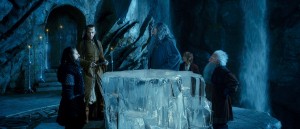 In the movie it’s not nearly so simple. You see, apparently the Elves in Rivendell have painstakingly built a ledge on a massive cliff-face complete with a special moon-table. To read moon-letters, you must gather around this table and place the suspected moon-letter document on the table. The table then glows with moon-light and reveals what is on it. I can’t imagine this ledge gets much use — typical of the wealthy elves to be so wasteful with space and function. Heh — yeah, I had a bit of a chuckle at that point.
In the movie it’s not nearly so simple. You see, apparently the Elves in Rivendell have painstakingly built a ledge on a massive cliff-face complete with a special moon-table. To read moon-letters, you must gather around this table and place the suspected moon-letter document on the table. The table then glows with moon-light and reveals what is on it. I can’t imagine this ledge gets much use — typical of the wealthy elves to be so wasteful with space and function. Heh — yeah, I had a bit of a chuckle at that point.
There is one BIG negative from my viewing of The Hobbit: An Unexpected Journey. It has nothing to do with the plot, acting, score or any other aspect of the actual content of the film. It has to do with wrapping this masterpiece in the inappropriate frame of HFR 3D. It was quite simply unnecessary to saddle this film with this presentational wizardry.
And it’s something I had hoped that was not going to be the case.
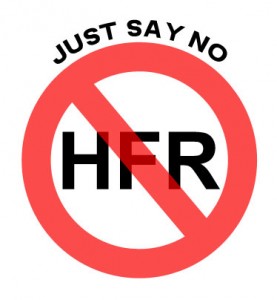 In fact, I was very excited to see this new technology and experience the ‘future of film.’ I was ready for it! Even with the uproar from those crusty cinema owners last year, I figured that was a bunch of old fogeys who simply didn’t want to update their equipment. I was fully expecting to be blown away and fall in love with this next evolution in film. I felt this way right up until the opening scenes of the movie. Then it happened…
In fact, I was very excited to see this new technology and experience the ‘future of film.’ I was ready for it! Even with the uproar from those crusty cinema owners last year, I figured that was a bunch of old fogeys who simply didn’t want to update their equipment. I was fully expecting to be blown away and fall in love with this next evolution in film. I felt this way right up until the opening scenes of the movie. Then it happened…
I told myself: ‘Oh Chris, your eyes will get used to it… just a bit longer.‘
Nope — never got used to it. I couldn’t help but think, ‘Why does this look like some highly produced BBC TV drama?‘ In fact, about every 10 minutes or so (or maybe whenever something was particularly bright on screen) I found myself being literally drawn out of Middle-earth and back into the present — the theater. And therein lies the issue. I was constantly taken out of the story and performance because my brain was distracted by the ‘bells and whistles’ on screen. I was jolted out of the content of the film and noticed the tech behind it. That is unfortunate.
The Hobbit: An Unexpected Journey is a great movie that is saddled with this unnecessary mission to advance the future of film. So here’s my slightly controversial suggestion: Watch this film first in good ole fashioned 24fps. Then, for your second viewing, go and see it in HFR. This way your initial experience won’t be compromised by the tech and second-time-round you may actually be able to enjoy the high frame rate as well!
As an aside, I did consider that I’m simply too old for this type of presentation. I’m 38. I don’t play video games and don’t run out to see IMAX or 3D viewings of films on a regular basis. So maybe the thirteen-year-olds of the world will love it.
To summarize, rush out and see The Hobbit: An Unexpected Journey and enjoy the ride! As long as you bring along your inner child you’ll have a wonderful time. If you have a choice, DO NOT see it in 48fps for your first viewing.
9/10 Rings
– Calisuri.
[sws_green_box box_size=”600″]
Related stories:
The Hobbit: an expected masterpiece in a distracting frame
The Hobbit’s dwarves: Too hot to handle?
MrCere reviews ‘The Hobbit: An Unexpected Journey’
Staffer Garfemaio reviews ‘The Hobbit: An Unexpected Journey’
[/sws_green_box]
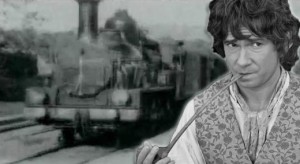 At the first public showing of a movie picture depicting a train coming toward the viewers, people scattered in alarm trying to get out of the way. Or so the story goes. Some will do the same with director Peter Jackson’s new film The Hobbit: An Unexpected Journey.
At the first public showing of a movie picture depicting a train coming toward the viewers, people scattered in alarm trying to get out of the way. Or so the story goes. Some will do the same with director Peter Jackson’s new film The Hobbit: An Unexpected Journey.
The irony is that The Hobbit’s titular character, Bilbo Baggins, doesn’t like to take risks in a film that revels in them.
It’s visionary stuff, and Jackson is alone on the frontier with only James Cameron visible on the horizon. The first installment of The Hobbit trilogy is new cinema.
Instead of playing safe and comfortable in lower-risk financial zones, Jackson has pushed the boundaries with 3D, with 48 frames of film per second -– or the digital equivalent — flashing past viewers’ eyes instead of the traditional 24fps. It is definitely different.
The filter of the traditional look of cinema, what we are used to seeing in the dark, is gone. Forever? Consumers will ultimately decide but studios continue to churn out films in 3D despite anything but universal acclaim.
Here, Jackson has gone to such lengths to make the fantastic look real that for many the film will look unreal -– but only if viewers choose to see it in the director’s preferred way. Of the approximately 24,000 theaters that will display The Hobbit: AUJ, around 1,000 will have the technology to display it as it was shot — HFR 3D. But, for those 1,000, hang onto your arm rests, cinema has just leapt forward.
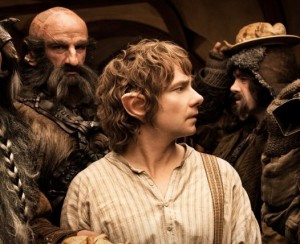 Bilbo Baggins (masterfully portrayed by Martin Freeman in a performance that will be lost amidst the eye-popping action sequences), as many readers will know, relishes his comfortable life in the cinematically familiar Bag End. He is interrupted by a gaggle of dwarves and a meddlesome wizard who for reasons he cannot himself explain, thinks Bilbo needs to travel with the dwarves.
Bilbo Baggins (masterfully portrayed by Martin Freeman in a performance that will be lost amidst the eye-popping action sequences), as many readers will know, relishes his comfortable life in the cinematically familiar Bag End. He is interrupted by a gaggle of dwarves and a meddlesome wizard who for reasons he cannot himself explain, thinks Bilbo needs to travel with the dwarves.
All of this is familiar ground for readers of Tolkien’s original tale. And, as expected, the screenwriters (Fran Walsh, Phillipa Boyens, Guillermo del Toro and Peter Jackson) make great effort to up the stakes and ramp-up the tension.
People who haven’t been paying attention to the promotional lead-in campaign may be surprised to find that joining Freeman and Ian McKellen’s Gandalf as lead characters in the film is Richard Armitage as Thorin Oakenshield. It’s a role likely to launch Armitage, blessed with an already-fervent fanbase, masculine good looks, and ample ability, into the stratosphere. The character is deeply scarred and tragic. Thorin gives the children’s tale a Shakespearean disaster angle and the film makes the most of it in in ways that may not surprise viewers but will nevertheless delight them.
 Andy Serkis returns to work his performance-capture magic as Gollum, and Jackson and his actors reach the peak of performance and technical … well … wizardry in a scene that is the film’s best. Despite being dialog-heavy, it is cinematic magic.
Andy Serkis returns to work his performance-capture magic as Gollum, and Jackson and his actors reach the peak of performance and technical … well … wizardry in a scene that is the film’s best. Despite being dialog-heavy, it is cinematic magic.
So Bilbo, content to play it safe in a movie that most definitely isn’t, is joined by all these dwarves who despite excellent design and characterization, just don’t have enough room in the movie. Considering Jackson’s Middle-earth legacy, many viewers will immediately begin pondering extended editions and hope for more from these characters.
Then -– especially if they see it in 48 fps -– they’ll want to schedule another viewing. This writer’s initial reaction to the film was wanting to see it again immediately. As of this writing, that has been impossible. Fans, and those who care about film as an art form (and perhaps as a science) will want to view The Hobbit: An Unexpected Journey in both its incredibly clear new format and as a traditional film.
Others, the Bilbo Baggins of the world, are perhaps better advised to simply see the film as they saw The Lord of the Rings. They will be thrilled with adventure and the interplay of now-familiar movie characters playing again inside the incredible landscapes of Middle-earth. Peering deeper into dwarven culture will come with a (pun-intended) deep satisfaction and they will be thrilled, despite some dark days for fans, back in a delightful rendition of Jackson’s Middle-earth..
It goes without saying that not everybody will like everything. Setting aside technology for a moment, sections of the film that delight some will frustrate others.
In one place Gandalf reuses a familiar story-telling device. For some that will hearken back to the familiar. For others it will seem like a rehash. There are a handful of such moments. The 100% CGI orc Azog may feel cartoon despite (or because of) his technical perfection; he is no Gollum. But putting aside the quibbles, Jackson has delivered a tightly paced action flick that is rollicking fun. He has captured again the magic of Tolkien’s world with his own stylistic, cinematic stamp.
Radagast the Brown is a delight and injects some of the fringe legends of Tolkien’s own hand and some of the lighter tone of the source material into the sometimes dangerously heavy Middle-earth. There is the expanded Goblin Town with its madcap action – more jolly than peilous – which takes license with underground kingdoms. But amidst all this fun we are tossed a dozen decapitations as well creating a puzzle for some parents and sensitive younger viewers. Cate Blanchett casts her graceful spell along with the most welcome Christopher Lee and appropriate the slightly less stressed Elrond from Hugo Weaving, iconic in his own right.
The dead-on casting with exemplary performances from the leads as well as those in small roles make the fantasy feel real more than any technician can -– and the technicians on this film are world-class here. And yes, fantasy films can have exemplary performances and actors selling the fantastic as the everyday, have achieved high-craft in their art. Technically masterful, this adaptation of a classic children’s tale is grand and glorious cinema that is indeed lighter than its Rings cousin but also with nasty battle elements.
 What’s more, any discussion about the need for three films or the making the decision to do so based on anything but storytelling merits couldn’t be more incinerated if Smaug himself engulfed the conversation in dragon’s fire. The case for three films is settled.
What’s more, any discussion about the need for three films or the making the decision to do so based on anything but storytelling merits couldn’t be more incinerated if Smaug himself engulfed the conversation in dragon’s fire. The case for three films is settled.
But being first is difficult. Like Ebay selling its first item in 1995 (a laser pointer if you must know) new things can take a while to catch on. The lion’s share of reviews are going to address the step forward in display technology (including this one!) but the story will sink or swim because of the characters, their situations and the craft with which they are brought to life.
Viewers need to evaluate: Are they Bilbos? Do they want safe, familiar cinema or do they want to go on an adventure at the theater? The comparison isn’t mine originally but I like best the thought that somebody has taken the window out and now we are not looking through the filter of film but looking at the real world. It will take some adjusting.
Will you like it? Well, do you embrace change? Can your entertainment tastes evolve? This is like nothing you have ever seen and it will jar not just your eyes but your brain. The dragon slayers will revel in the new and the adventure. Not every note will ring true for every viewer but whatever else, this movie is about fun and adventure.
And (something that will obviously delight the studio) the real answer to this riddle is that this is a film that cries out to be seen in both formats and compared by the viewer. It is entertaining entertainment but it is also a landmark of technology and a test of crowd behavior. I agree with Jackson and Cameron; this is the future.
Whatever the public and critics conclude, Jackson and his team must be admired for operating on wires high above the crowd with no net or safety line with fearlessness and passion. As for me, I will take that at my cinema experience every time over another action film content to play it safe.
NOTE: Larry D. Curtis spent five weeks on the set during film of The Hobbit and freely acknowledges his opinion of this film is compromised. Further, he is dying to see the film again to have a more informed opinion.
[sws_green_box box_size=”600″]
Related stories:
The Hobbit: an expected masterpiece in a distracting frame
The Hobbit’s dwarves: Too hot to handle?
MrCere reviews ‘The Hobbit: An Unexpected Journey’
Staffer Garfemaio reviews ‘The Hobbit: An Unexpected Journey’
[/sws_green_box]
 TheOneRing.net staffer Garfeimao and long-time TORn friend Nancy Steinman were able to secure tickets to the World Premiere of The Hobbit: An Unexpected Journey. Here are Garfeimao’s largely spoiler-free thoughts on what she saw. Continue reading “Staffer Garfemaio reviews The Hobbit: An Unexpected Journey”
TheOneRing.net staffer Garfeimao and long-time TORn friend Nancy Steinman were able to secure tickets to the World Premiere of The Hobbit: An Unexpected Journey. Here are Garfeimao’s largely spoiler-free thoughts on what she saw. Continue reading “Staffer Garfemaio reviews The Hobbit: An Unexpected Journey”
 Courtesy of RichardArmitageNet, here’s some vision from the Japanese premiere of The Hobbit — attended by Peter Jackson, Martin Freeman (Bilbo), Andy Serkis (Gollum), Richard Armitage (Thorin), Elijah Wood (Frodo) and Hugo Weaving (Elrond). Some nice interviews to pick over, too.
Courtesy of RichardArmitageNet, here’s some vision from the Japanese premiere of The Hobbit — attended by Peter Jackson, Martin Freeman (Bilbo), Andy Serkis (Gollum), Richard Armitage (Thorin), Elijah Wood (Frodo) and Hugo Weaving (Elrond). Some nice interviews to pick over, too.
The premiere was held at the TOHO Cinemas Roppongi Hills and preceded by a red carpet event similar to the one held as part of the world premiere this week in Wellington. Continue reading “Video: footage from Japanese Hobbit premiere”
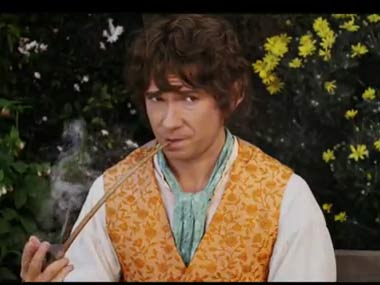 Only Twitter users and a part-time critic at the New York Daily News have so far broken the embargo on Jackson’s return to Middle-earth. But, The Guardian asks, is the film verdict-proof anyway? Continue reading “An unexpected wait for Hobbit reviews”
Only Twitter users and a part-time critic at the New York Daily News have so far broken the embargo on Jackson’s return to Middle-earth. But, The Guardian asks, is the film verdict-proof anyway? Continue reading “An unexpected wait for Hobbit reviews”


